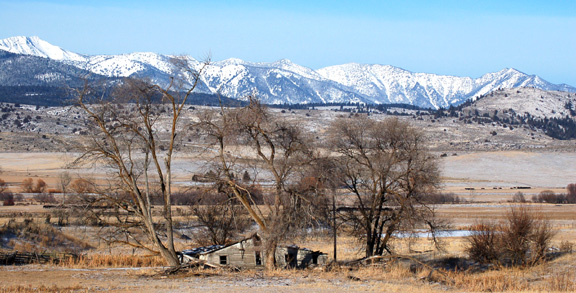I re-posted the original several paragraphs below due to the current interest in the wolf situation generated by the April incident near Keating, Baker County, Oregon, and because Oregon Public Broadcasting did a Think Out Loud segment this morning concerning the conflicts arising due to the wolf's homecoming. I had wanted to ask about the rancher's responsibility to protect their livestock and whether much effort was expended to do that prior to the Baker County wolf incidents. After remaining on hold for almost 15 minutes, the program ended without my being able to speak and without the moderator asking the question which had been provided earlier to the screener.
People are aware that living in the country presents certain risks, including the possible loss of domestic animals to native predators. When people are aware of a threat, they usually provide adequate security for their animals. I myself raise chickens and I provide them with secure pens made of dog kennel fencing with extra chainlink buried along the edges of the pens to prevent digging under. So what I'm wondering, what with some 6 guard dogs, and the sheep so close to the house, just how were the wolves able to get to the lambs, and how could they have done it without the dogs raising enough ruckus to alert the owners that they had a problem to attend to? They knew (despite Congressman Walden's claims http://www.bakercityherald.com/Local-News/Walden-Move-the-wolves-to-wild-areas ), as everyone out here knew, that the wolves had come home, and an April 16th Oregonian article, "Wolves kill 23 lambs. . . ." wrote that "Jacobs saw a wolf last year, and neighbors have reported them in the area recently, he said."
A search on "Wolf proof fencing" reveals that many designs for wolf-proof fencing have been developed. One article from 1982 describes such fencing being developed in 1935. (THE USE OF FENCES FOR PREDATOR DAMAGE CONTROL http://digitalcommons.unl.edu/cgi/viewcontent.cgi?article=1046&context=vpc10 )
The facts are that wolves are responsible for about 1% of livestock losses in Idaho, a state with around 1600 wolves at the time of delisting. In Wisconsin, a state with about 2600 wolves, about 30 to 50 livestock animals are lost due to wolf depredation each year. With over 3 million cattle and calves alone, this represents a very small fraction of 1% of cattle, calves and sheep (something like less than 1/100th of a percent) in Wisconsin. These are hardly the kinds of numbers that could justify the current hysteria about wolves coming back to Oregon that exists among ranchers and others.
Defenders of Wildlife provides the following facts and more at http://www.defenders.org/programs_and_policy/wildlife_conservation/solutions/wolf_compensation_trust/wolf_predation_and_livestock_losses.php
Wolf Predation Plays Small Role in Livestock Losses in 2005
"In the continental U.S., health issues such as respiratory problems, digestive problems, calving complications and disease were overwhelmingly the most significant causes of cattle death in 2005.
- Only 0.11% of all cattle losses were due to wolf predation in 2005.
- Coyotes killed more than 22 times more cattle than wolves killed that year.
- Domestic dogs killed almost 5 times as many cattle, and vultures killed almost twice as many cattle as wolves did in 2005.
- Theft was responsible for almost 5 times as many cattle losses as were lost by wolf predation.
- Predation by coyotes was the largest cause of sheep loss in 2005, accounting for 23% of all losses, followed by health problems & weather-related issues.
- In states with wolf populations, an average of less than 2.5% of sheep loss was due to predation by wolves in 2005.
Only 5% of all cattle losses in the continental U.S. in 2005 were attributable to predators. In addition, only 0.11% of all cattle losses in 2005 were due to predation by wolves. Coyotes killed more than 22 times more cattle, domestic dogs killed almost 5 times as many cattle, and vultures killed almost twice as many cattle as wolves did in 2005. Interestingly, theft was responsible for almost 5 times as many cattle losses as were lost by wolf predation."
So why is it that everyone else takes it as reasonable that they are completely responsible for protecting their animals, but the Cattleman's Association and many ranchers think they are different? They might say, well, after we and the government won our little war on the wolf, we expected that people would let us continue the persecution forever, even on public lands. Fortunately, this isn't 1946; people now realize the value of predators, and they want their wolves back. Ranchers will just have to start acting like the rest of us by bearing the expense of protecting their animals, and if they put them on public lands where wolves are present, they should expect some uncompensated losses. They already receive large government subsidies and only pay $1.35 a month, less than what it costs to feed a hamster, for having a cow and her often half-grown calf eating and tearing up riparian areas on the public lands. No doubt they can deduct it from their tax liabilities, if any.
It was interesting to hear the Cattlemen's Association President talk about the "passion" ranchers have for wildlife, and to hear a caller from N. Powder speak about the East-West divide and the lack of respect shown for ranching tradition in Eastern Oregon and elsewhere in the west. My blog from December 2007, describes some of that passion and tradition. It explains the relationship between ranching and the persecution, and extirpation or near extirpation, of native predators, including the wolf. The U.S. Department of Agriculture Year Book for 1920, where classics like “Hunting Down Stock Killers” and “Death To The Rodents” can be found, details with words and pictures the morbid and passionate tradition. Today, at the behest of ranchers, Baker County still uses taxpayer dollars to gun down coyotes from helicopters every winter.
You can download Defender's "Livestock and Wolves: A Guide to Nonlethal Tools and Methods to Reduce Conflicts" at:
http://www.defenders.org/resources/publications/programs_and_policy/wildlife_conservation/solutions/livestock_and_wolves.pdf
Chris
Wolves

Gray Wolf (Canis lupis) [USF&WS Photo]
I enjoyed the Herald Tuesday’s article by Jayson Jacoby on the dispersal of wolves into North East Oregon. It was gratifying to see it as it helps confirm my sighting of a pair of wolves near Lick Creek (Wallowa County) in August of this year. I reported the sighting to the Fish & Wildlife Service that month, but apparently they were unable to independently confirm it. Good that the snow held the tracks found by a local rancher, hopefully not one of the “shoot, shovel, and shut-up” up crowd, so that wolves could be confirmed this year. We should be relieved that the wolf has finally come home. I look forward to hearing their howls in the coming years but predator persecution has a long history in America, and in Eastern Oregon in particular (2 of 4 recent wolf migrants have been shot). Hopefully the State and Federal government will take their responsibilities seriously and protect the wolves from those who have vowed to stop their reintroduction here.
In America, the practice of predator persecution by the agricultural “producer” community has its roots in the insecurity of an expanding agrarian pioneer population dating back to the arrival of Europeans on this continent during the 1600’s. It has since spread to the hunting industrial complex, which has concerns that it will reduce numbers of “game” species, like elk and deer, which in turn could reduce the number of tags allowed and licenses sold. This could lower income to the State hunting bureaucracy, to gun shops and ammunition dealers, and ultimately to local communities who depend on the flush of hunter dollars in the fall. (On the other hand, it might bring the curious into the area hoping to view or hear wolves.)
Bounties on wolves were offered as early as 1630 in the Massachusetts Colony, at which time, some 250,00 or more wolves roamed America’s wild lands. By about 1700, wolves had been eliminated from the Eastern United States. According to the Wild Rockies Alliance, “Professional ‘wolfers’ working for the livestock industry laid out strychnine-poisoned meat lines up to 150 miles long. Wolves were shot, poisoned, trapped, clubbed, set on fire and inoculated with mange, a painful and often fatal skin disease caused by mites.” The persecution reached its apex in the late 1800’s and into the early years of the last century, by which time it is estimated that some 55,000 wolves a year were being executed. Between 1918 and 1920, over 128,500 wolves were slaughtered in the Western U. S.
A palpable hatred for both predators and other “varmints” is revealed in articles printed in the U.S. Department of Agriculture Year Book for 1920, where classics like “Hunting Down Stock Killers” and “Death To The Rodents” can be found.

Some quotes:
“Uncle Sam, tired of a drain on his resources of from $20,000,000 to $30,000,000 every year through the slaughter [slaughter is to be reserved for humans alone] of domestic stock by predatory animals, now keeps constantly in the field a force of hunters who are instructed to wipe out these nonproducers. In their place, and safe from their depredations, it is the aim to populate the range country [I.e., primarily public lands] with flocks and herds….”
. . . .
“Losses of live stock from ravages of predatory animals are among the most spectacular and exasperating of those suffered by the stockman. Disease may decimate his flocks and herds, or drought or wintry storms may result in the starvation or death of numbers of valuable animals. None of these disasters, however, arouses such resentment and determination to settle the score as arises in the heart of the ranchman when wolves or other stock destroyers enter corrals or operate on the open range [public lands], maiming and killing his cattle or other domestic stock.”
. . . .
“Men with keen insight into animal psychology and the ways and motives of wild creatures had sought out improved methods of luring them to destruction when their presence was detrimental to the live-stock business.”
. . . .
“Careful field studies of the abundance, habits, and relationship of predatory animals to the live-stock industry had been made by the Biological Survey of the United States Department of Agriculture for many years.”
. . . .
“. . . the death of the Custer wolf was hailed with delight by stockmen throughout the region where the depredations had occurred, and has added to the impetus to a movement for cooperation with the Department in order to meet more adequately the needs of the live-stock industry.”

“Evidence that Uncle Sam’s Hunters Get results”
In another part of the article titled “’Getting’ the Chief Offenders,” a caption, under a photo of trapped coyotes and wolves, and of a “hunter” spreading poisoned baits, states: “Trapped coyote—more than 250,000 of his ilk have been accounted for [killed] in five years by Federal and cooperating hunters.” [Emphasis added]
It is clear from these attitudes that the American people are expected to sacrifice their public ecosystems, and all the species there-in, (not to mention their tax dollars flowing to the U.S.D.A predator control efforts, Forest Service, and Bureau of Land Management) to the economic interests of ranchers. In practice, that is exactly what has occurred. Like every thing else in our corrupt American “democracy,” the theft of our public lands and ecosystems has been financed by the economic power of special interest groups like the various Cattlemen’s Associations. This is accomplished through their financial contributions to members of Congress, especially in districts where extractive industries and ranchers have large landholdings with the significant economic and social power that those holdings bring.

And it is not just native predators who suffer. Prairie dogs and other important rodents have suffered as well. As the picture above illustrates, prairie dogs, and those who depend on them, like the black-footed ferret, have been the targets of the stockman’s jihad. Hawks and many other species depend upon the availability of a prey base, which consists largely of rodents, for their survival.

Black-Footed Ferret [USF&WS Photo]

Black-Tailed Prairie Dog [USF&WS Photo]

Swainson’s Hawk [Photo © Christopher Christie]
My question, and that of many in the environmental community, is why should ranchers or hunters have control over which of our native predators should be allowed to have access to their historic habitat on our public lands? The wolf has an important role in maintaining the health of our public ecosystems. If public lands ranchers insist on putting their livestock in a situation where they will naturally become prey, then that is their problem. Our lands should not be managed for the benefit of ranchers and hunters, our lands should be managed for the benefit of native ecosystems and the services they provide for all of the American people.
[For old letter on predator control see:
http://www.rangebiome.org/editorials/oregonwolves.html ]












No comments:
Post a Comment